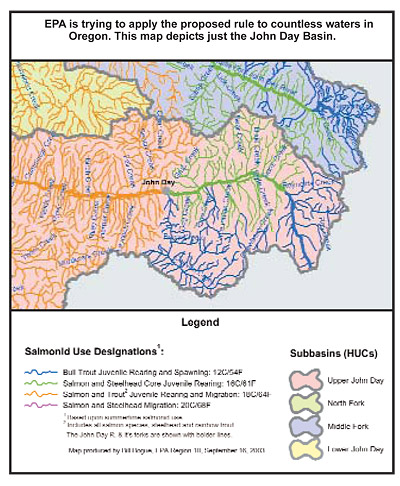All Articles
Free
Legislative and Regulatory Update
November 2003 by Staff
• Comments needed from small-scale miners in Oregon
Small-scale miners in Oregon should be aware that the EPA is proposing water quality standards for streams and rivers that could place additional restrictions on mining in waterways.
The EPA published a proposed rule that would call for the following:
•use designations for critical life stages of certain salmon, trout, and other cold water fish species (“salmonids”) in Oregon waters
•temperature water quality criteria for the protection of salmonids in Oregon waters, except for the Columbia River
•an intergravel dissolved oxygen water quality criterion to protect salmonid spawning wherever salmonid spawning is the designated use
•methods to implement Oregon’s existing antidegradation policy
The EPA-initiated peer review panel noted some problems with the EPA’s recommendations. A few comments  from the peer review panel are noted:
from the peer review panel are noted:
“As the EPA notes, there is scientific uncertainty regarding the effects of fluctuating temperature, availability of food resources, and fish responses.”
“Use of warmer than optimal habitat does occur, but panelists were not aware of studies examining use of warmer than optimal habitats when optimal habitats were also available.”
“There have been very few studies of the effects of restoration on summer maxima, and less data exists for other times of the year.”
“Even after 7 years studying fish and temperature in the basin I’m most intimate with, I’d have to rely on an unreasonable amount of guesswork to implement this concept.”
The full Internet address to access the EPA’s information page on this proposed rule is excessively long. The easiest way to locate the proposed rule on the Internet is to go to www.google.com and enter “Docket ID No. OW-2003-0068” in the search window. Hit your enter button and the website link will appear at or near the top of the list.
To obtain information by the old fashioned method, contact Mary Lou Soscia, US EPA Region 10, 811 S.W. Sixth Ave, Portland, Oregon 97204; phone: (503) 326-3250.
To submit comments, send them by mail or hand delivery/courier to Valerie Badon, ORC-158, US EPA Region 10, 1200 Sixth Avenue, Seattle, Washington 98101; or by electronic mail (e-mail) to OW-Docket@epa.gov Write “Attention Docket ID No. OW-2003-0068” in the subject line.
EPA is providing only a 30-day comment period due to a court order following a lawsuit by Northwest Environmental Advocates, so get educated and get your comments in by November 9, 2003. Your first comment should be to provide a more reasonable, 90-day comment period.
• News from the House and Senate
House and Senate Republicans agreed on a sweeping package of energy development incentives but could face a filibuster by Democrats when it comes time to vote on the package. A filibuster would require 60 votes in the Senate to pass, and it would be difficult for Republicans to muster that many votes.
The package includes the controversial provision for drilling in the Arctic National Wildlife Refuge (ANWR), and federal eminent domain power for rights-of-way. Western governors are opposed to the eminent domain provision, which would give the Federal Energy Regulatory Commission the right to take private property when needed for electrical lines.
The House of Representatives voted 185-to-234 to reject a bill that would have forced the Bush administration to implement the Clinton Roadless Rule and prohibited roads in 58.5 million acres of national forest lands.
Utah Governor Mike Leavitt’s nomination to become head of the Environmental Protection Agency was blocked by Senate Democrats and one Independent on the Senate Environment and Public Works Committee. They boycotted a scheduled vote on the nomination, preventing the committee from voting because not enough members were present for a quorum.
• Governor shows support for mining
Alaska Governor Frank Murkowski made his support for mining crystal clear by hand delivering a long overdue Environmental Impact Statement (EIS) to Sumitomo Metal Mining Corporation.
“We deliver,” said Murkowski, as he handed over the EIS wrapped in Alaska’s blue and gold colors.
The complete EIS allows for state and federal permits to be issued for the Pogo Mine, east of Fairbanks.
When Murkowski was elected he stated he will do whatever is necessary to speed up the government permitting process. In March 2003, he disbanded the Alaska Fish and Game division and gave its permitting duties to the state Department of Natural Resources after accusing division staff of stalling projects and leaking information to outside organizations.
“I have appointed a well-experienced team to make environmentally responsible decisions in a prompt manner to speed up the state licensing,” said Murkowski. “We have a good working relationship with you.”
He added that he had appointed Bill Jeffress, former assistant mine manager at Fort Knox, to manage and oversee the state’s role in the Pogo Mine development.
Sumitomo Metal Mining would like to begin delivering equipment to the mine site in January. Murkowski assured Fukushima that access to the site would be available commensurate with Sumitomo’s schedule. 
© ICMJ's Prospecting and Mining Journal, CMJ Inc.